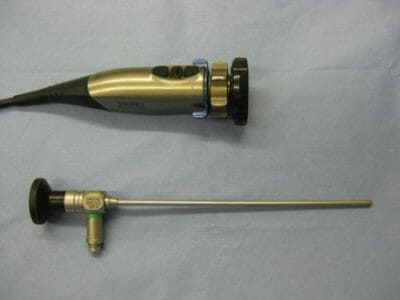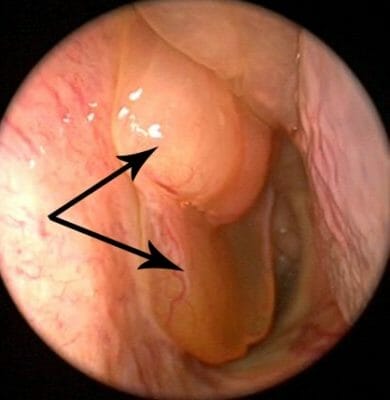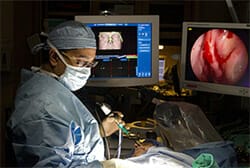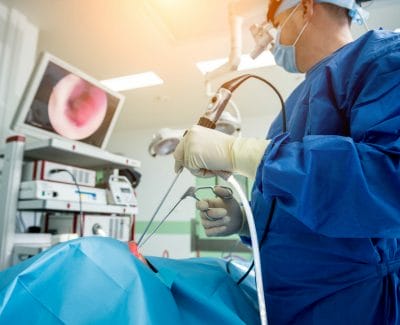Introduction
Over the past few decades, sinus surgery has evolved significantly. It was once performed through external incisions. It often required extensive nasal packing (i.e. gauze or other material placed in the nose to control bleeding after surgery). Significant pain and a long recovery were common.
Advances in technology have allowed sinus surgery to be performed entirely through the nose. Incisions on the face or in the mouth are rare. One important development is the nasal endoscope. It is a small, lighted metal telescope placed into the nostril. The endoscope allows the surgeon to see inside the nose and sinuses (See Nasal Endoscopy). Today, endoscopic sinus surgery is typically done with minimal nasal packing, little pain, and short recovery times.

Why Is Endoscopic Sinus Surgery (ESS) Performed?
The most common reason for doing sinus surgery is “chronic rhinosinusitis”/ “chronic sinusitis” (See Adult Sinusitis). Chronic rhinosinusitis is a general term for inflammation (swelling) of the nose and sinuses. (See Nasal Polyps) Chronic means that the inflammation has been present for at least 3 months. The inflammation can be caused by infection, allergies, irritants, and many other things. Many times, we do not know exactly why patients have chronic sinusitis.
Serious infections in the brain or eye might also be a reason for sinus surgery. Nasal polyps are a sign of severe inflammation. They can also be a reason for surgery. ESS is also used to treat select cases of sinonasal tumors, leakage of brain fluid into the nose (See Cerebrospinal Fluid Leak), and eye conditions (See Orbital Decompression and Optic Nerve Decompression). Each individual case is different. Your sinus surgeon will determine if surgery is the best choice for your nasal/sinus problem

What Treatments Should Be Tried Before Endoscopic Sinus Surgery?
Before having sinus surgery, medical treatments have usually been tried. Treatments may include both prescription and over-the-counter medicines. For sinus infections, antibiotics are the main treatment. In addition, nasal saline rinses or sprays may be used. Nasal decongestant sprays (ie. pseudoephedrine and oxymetazoline) can be used to treat nasal stuffiness. However, they should not be used longer than three days. Long term use can actually worsen symptoms. Decongestants also have multiple side effects. Patients should check with their doctor or pharmacist regarding use.
If a sinus infection or inflammation lasts beyond four weeks and becomes a more chronic illness, treatments may change. Antibiotics may be used for longer than a typical 10-14 day course. A sinus culture may be taken to help choose the best antibiotic to treat your sinuses. Steroid nasal sprays and/or steroids taken by mouth may also be used to decrease inflammation. If allergies play a role, allergy medications may also be given. Your physician may order a CT (“cat”) scan of your sinuses.
What Are The Benefits of Endoscopic Sinus Surgery?
When medicines fail, endoscopic sinus surgery may be helpful. There are several goals of sinus surgery. The main goal is to improve the drainage of the sinuses by widening the openings of the sinuses. Patients with blockage of their sinuses due to their sinus anatomy do well with sinus surgery. Many patients have additional causes of inflammation of the sinus lining. Patients with additional sources of inflammation also usually improve with sinus surgery. Creating larger sinus openings allows the medicines to penetrate deeper and decrease the swelling. Chronic sinusitis is a chronic problem. Surgery is done in addition to, and not instead of, medical treatment of the sinuses. Surgery is not a cure for sinusitis, but it is an important step for some patients.
Does Anything Need To Be Done In Preparation For My Endoscopic Sinus Surgery?
Most surgeons recommend that patients avoid any medications that may lead to bleeding, such as NSAIDs, aspirin and blood thinners. In addition, vitamin E, garlic, ginger, gingko, and ginseng may increase the risk of bleeding. Some patients may be asked to take antibiotics and/or steroids prior to sinus surgery. If you have any questions about which medications you should or should not take, you must ask your surgeon. Most surgeons will provide a list of medications for their patients to avoid prior to surgery. Aspirin and blood thinners should not be stopped before speaking with the physician who prescribed the medication.
How Is Endoscopic Sinus Surgery Performed?
Endoscopic sinus surgery may be done under local or general anesthesia. Local anesthesia involves numbing the nose and sinuses, but the patient remains awake for surgery. General anesthesia means that the patient goes to sleep with anesthesia. ESS involves the use of a small telescope (nasal endoscope), a microdebrider (a device that cuts tissue and sucks it away), and fine instruments to gently handle the sinus tissue. Sometimes, balloons may also be used to widen the sinus openings (See Balloon Sinuplasty).

Most people have four sinuses on each side of their face, for a total of eight sinuses (See Sinus Anatomy). These are the maxillary, ethmoid, sphenoid, and frontal sinuses. The maxillary sinuses are in your cheek. The ethmoid sinuses are between your eyes. The sphenoid sinuses are almost exactly in the center of your head. Finally, the frontal sinuses are in your forehead. Sinusitis may affect some or all of your sinuses. Your symptoms, examination, and CT scan will determine which sinuses need to be opened. Sometimes during sinus surgery, the nasal septum, which divides the two sides of the nose, is also straightened. The turbinates, which filter and moisten air inside of the nose, may require surgery as well. (See Septoplasty and Turbinate Surgery).
What Is the Recovery After Endoscopic Sinus Surgery?
The use of nasal packing is less common than it was in the past. However, it may be used depending on the case or the surgeon. Many people do not have much pain after sinus surgery, but every patient is different. Depending on the extent of your surgery, you may be prescribed stronger pain medicine. Generally, pain, congestion, and drainage should improve after the first few days. Mild symptoms sometimes linger for several weeks after the surgery. Your surgeon may also place you on medications after surgery. Saline rinses, steroids, and antibiotics are common.
Your surgeon will provide specific instructions as to what activities are allowed and what must be avoided. In general, excessive pressure to the head should be avoided. Instructions commonly include not blowing the nose, avoiding bending over and lifting heavy weights, keeping the head elevated and adhering to light activity.
Will Endosocopic Sinus Surgery Improve My Symptoms?
The majority of patients who have endoscopic sinus surgery do very well, with significant improvement in their symptoms.
What Is “Sinuplasty” (A.K.A Balloon Sinuplasty or Balloon Dilation)?
“Sinuplasty” refers to a procedure to dilate the sinus openings with a balloon. Sinuplasty maybe a less invasive alternate to ESS in the correct patient. It is important to talk with your surgeon to determine the best option to treat your sinus disease.
What Are the Potential Complications of Endoscopic Sinus Surgery?
Complications of sinus surgery are rare but include bleeding, damage to the eye or vision, intracranial complications (brain injury, brain fluid leak, infection of the brain), and anesthesia complications among others. However, it is important to realize that the sinuses are located next to eyes and directly beneath the bottom of the brain. Failure to treat chronic rhinosinusitis itself may lead to severe problems. If you are uncomfortable with the risks of sinus surgery, it is important that you discuss this with your surgeon.
What Are the Alternatives to Endoscopic Sinus Surgery?
Continuing medical therapy alone and avoiding surgery is always an alternative. Medical therapy is chiefly antibiotics and/or steroids combined with other medications. As with any surgery, you should feel more than comfortable seeking a second opinion from another surgeon.
What Is Endoscopic Skull Base Surgery?
Endoscopic skull base surgery is a technique similar to ESS except that the surgery is focused on removing tumors or fixing abnormalities located at the bottom of the brain and/or the brain itself. Like sinus surgery, cameras, video equipment, and other instruments allow the surgeries to be completed entirely through the nose without any facial incisions. Unlike earlier techniques used, this technique may be significantly less painful and result in a shorter hospital stay. While this type of surgery is an attractive option, it must be emphasized that this technique is not for all patients or tumors. Your surgeon will be able to tell you if you are an appropriate candidate.
Copyright © 2020 by the American Rhinologic Society

